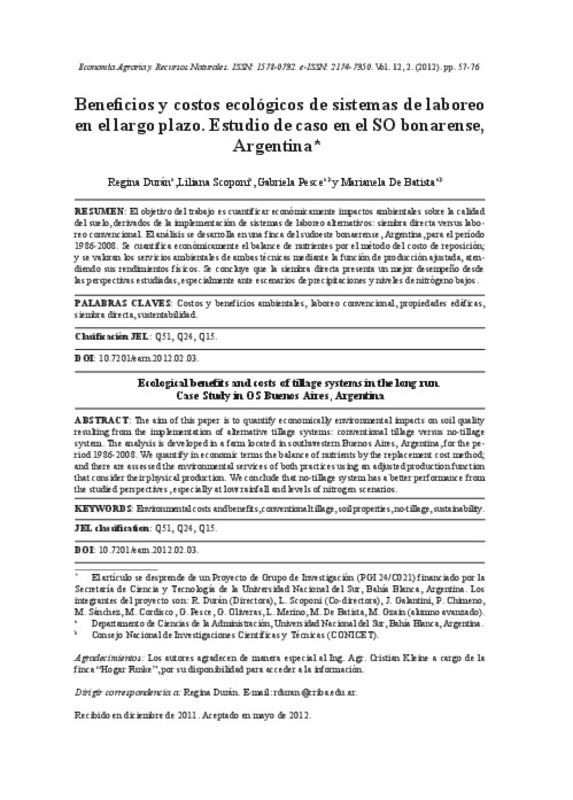JavaScript is disabled for your browser. Some features of this site may not work without it.
Buscar en RiuNet
Listar
Mi cuenta
Estadísticas
Ayuda RiuNet
Admin. UPV
Ecological benefits and costs of tillage systems in the long run. Case Study in OS Buenos Aires, Argentina
Mostrar el registro sencillo del ítem
Ficheros en el ítem
| dc.contributor.author | Durán, Regina
|
es_ES |
| dc.contributor.author | Scoponi, Liliana
|
es_ES |
| dc.contributor.author | Pesce, Gabriela
|
es_ES |
| dc.contributor.author | De Batista, Marianela
|
es_ES |
| dc.coverage.spatial | east=-59.84106969999999; north=-37.2017285; name=Azul Partido, Buenos Aires Province, Argentina | es_ES |
| dc.date.accessioned | 2019-03-11T10:44:40Z | |
| dc.date.available | 2019-03-11T10:44:40Z | |
| dc.date.issued | 2012-11-26 | |
| dc.identifier.issn | 1578-0732 | |
| dc.identifier.uri | http://hdl.handle.net/10251/117950 | |
| dc.description.abstract | [EN] The aim of this paper is to quantify economically environmental impacts on soil quality resulting from the implementation of alternative tillage systems: conventional tillage versus no-tillage system. The analysis is developed in a farm located in southwestern Buenos Aires, Argentina, for the period 1986-2008. We quantify in economic terms the balance of nutrients by the replacement cost method; and there are assessed the environmental services of both practices using an adjusted production function that consider their physical production. We conclude that no-tillage system has a better performance from the studied perspectives, especially at low rainfall and levels of nitrogen scenarios. | es_ES |
| dc.description.abstract | [ES] El objetivo del trabajo es cuantificar económicamente impactos ambientales sobre la calidad del suelo, derivados de la implementación de sistemas de laboreo alternativos: siembra directa versus laboreo convencional. El análisis se desarrolla en una finca del sudoeste bonaerense, Argentina, para el período 1986-2008. Se cuantifica económicamente el balance de nutrientes por el método del costo de reposición; y se valoran los servicios ambientales de ambas técnicas mediante la función de producción ajustada, atendiendo sus rendimientos físicos. Se concluye que la siembra directa presenta un mejor desempeño desde las perspectivas estudiadas, especialmente ante escenarios de precipitaciones y niveles de nitrógeno bajos. | es_ES |
| dc.description.sponsorship | Los autores agradecen de manera especial al Ing. Agr. Cristian Kleine a cargo de la finca “Hogar Funke”, por su disponibilidad para acceder a la información. | es_ES |
| dc.language | Español | es_ES |
| dc.publisher | Universitat Politècnica de València | |
| dc.relation.ispartof | Economía Agraria y Recursos Naturales - Agricultural and Resource Economics | |
| dc.rights | Reserva de todos los derechos | es_ES |
| dc.subject | Costos y beneficios ambientales | es_ES |
| dc.subject | Laboreo convencional | es_ES |
| dc.subject | Propiedades edáficas | es_ES |
| dc.subject | Siembra directa | es_ES |
| dc.subject | Sustentabilidad | es_ES |
| dc.subject | Environmental costs and benefits | es_ES |
| dc.subject | Conventional tillage | es_ES |
| dc.subject | Soil properties | es_ES |
| dc.subject | No-tillage | es_ES |
| dc.subject | Sustainability | es_ES |
| dc.title | Ecological benefits and costs of tillage systems in the long run. Case Study in OS Buenos Aires, Argentina | es_ES |
| dc.title.alternative | Beneficios y costos ecológicos de sistemas de laboreo en el largo plazo. Estudio de caso en el SO bonarense, Argentina | es_ES |
| dc.type | Artículo | es_ES |
| dc.date.updated | 2019-03-08T14:18:58Z | |
| dc.identifier.doi | 10.7201/earn.2012.02.03 | |
| dc.rights.accessRights | Abierto | es_ES |
| dc.description.bibliographicCitation | Durán, R.; Scoponi, L.; Pesce, G.; De Batista, M. (2012). Ecological benefits and costs of tillage systems in the long run. Case Study in OS Buenos Aires, Argentina. Economía Agraria y Recursos Naturales - Agricultural and Resource Economics. 12(2):57-76. https://doi.org/10.7201/earn.2012.02.03 | es_ES |
| dc.description.accrualMethod | SWORD | es_ES |
| dc.relation.publisherversion | https://doi.org/10.7201/earn.2012.02.03 | es_ES |
| dc.description.upvformatpinicio | 57 | es_ES |
| dc.description.upvformatpfin | 76 | es_ES |
| dc.type.version | info:eu-repo/semantics/publishedVersion | es_ES |
| dc.description.volume | 12 | |
| dc.description.issue | 2 | |
| dc.identifier.eissn | 2174-7350 |








